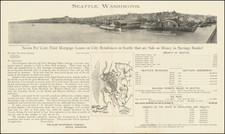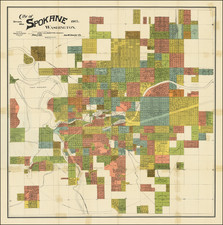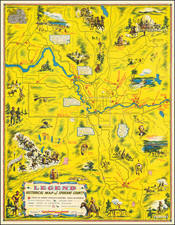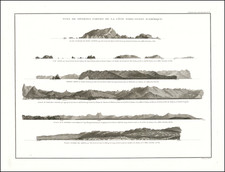"Rail Meets Sail" -- "One Hundred Miles of Stone, Brick and Asphalt Paved Streets"
Rare promotional view of the Seattle waterfront, published by the Ivy Press of Seattle, with an early photograph from Will E. Hudson, "Dean of Newsreel Men in the Pacific Northwest."
Published as a promotional view which was likely given away at the Alaska-Yukon-Pacific Exposition of 1908, the view promotes Seattle's ten miles of waterfront and one hundred miles of stone, brick and asphalt streets.
Includes a fine photographic view of the Seattle waterfront by Will E. Hudson, with smaller images showing:
- Seattle in 1878
- American Bank Building
- US Court House and Post Office
- White Building
- Looking down Westlake Blvd from Pike Street
- King Street Passenger Station
- Looking down Third Avenue from Yesler Way
- Looking down Pike Street from First Avenue
- Seattle Public Library
- New Washington Hotel
- Looking up Second Avenue from Yesler Way (slightly damaged)
- Looking up first Avenue from Pioneer Place
- Colman Building
- Alaska Building
Will E. "Bill" Hudson
The central photo includes a credit to Will E. Hudson, copyright 1908, the year prior to the earliest surviving examples of his film work and four years prior to the start of Hudson's career which would lead to him being called "Dean of Newsreel Men in the Pacific Northwest". The following is excerpted from the Watcom Museum's on line exhibit of Hudson's films:
Will E. "Bill" Hudson began working as a staff newsreel cameraman for Pathe News in 1916 and covered the Pacific Northwest for Pathe until his death on November 12, 1945. During the era in which newsreels reached the height of their popularity in the United States, Hudson was the acknowledged "dean of Newsreel men in the Pacific Northwest."
. . . Hudson's early professional work was in still photography. While attending college in Pullman before the turn of the century, he sold photographic prints to help pay his expenses. After graduation and marriage, Hudson and his wife, Dora, returned to Pullman in 1903 and jointly ran a successful photographic studio. The Hudsons and their two young daughters later spent two years in China, where Will shot outdoor photography under a contract with a Mr. C. L. La Munyon. Raising their two children far from home became difficult, so the Hudsons returned to the Northwest, and Will took a job as a photographer for the Seattle Post-Intelligencer.
. . . The earliest surviving footage credited to him was shot at the 1909 Alaska-Yukon-Pacific Exposition held in Seattle on the University of Washington campus. Footage of the AYP's opening day ceremonies, a downtown parade, and panoramic views are part of the Whatcom Museum's collection.
In 1912, Hudson purchased his own motion picture camera, and shortly thereafter he sold his first subject to International News for sixty cents a foot. In 1913-1914 he accompanied a Harvard-Smithsonian expedition destined for the Arctic aboard the ship Polar Bear in order to provide a filmed record of the trip. The expedition was not a success, and Hudson, along with Captain Louis Lane and others, had to hike out to safety when their ship became caught in the ice.
At the same time, another expedition aboard the ship Karluk was missing in the Arctic. Hudson's party were the only ones who could get out the news that the crew of the Karluk were safe. Hudson's account of the expedition, along with several of his photographs, was published in the Sunday edition of the New York Times, which had been following the Karluk's fate. Hudson's 1937 book Icy Hell tells of the entire adventure, and brief footage of the Polar Bear in the ice, of Hudson aboard the ship, and of the Arctic landscape, forms part of the Museum's collection.
Sobered by the Arctic experience, Hudson was only too happy in 1916 to take a job which kept him closer to home, filming Northwest subjects for Pathe News. In addition to his newsreel work, Hudson did camerawork on his own. With cutbacks in the newsreel business early in the 1930s, Hudson decided to shoot his own film. Adopting the style of African game-hunting films, which had been popular since Paul Rainey's 1912 African Hunt, Hudson shot his own "game picture" in the wilderness of his own back yard- the Pacific Northwest. The Whatcom Museum's collection includes substantial surviving footage from this endeavor, which Hudson entitled Bits of Outdoor Life from a Newsreel Cameraman. Of particular interest among the footage are scenes of former commercial fishing practices, including a whaling expedition aboard the vessel Aberdeen.
Rarity
OCLC locates 1 example (University of Utah).












![(Nothern Half) [Bancroft's Map of the Pacific States]](https://storage.googleapis.com/raremaps/img/small/54924.jpg)
![[ Mt. St. Helens Hazard Analysis Archive - Including Volcanic Ash ] Mount St. Helens Diary: A Sunday Holocaust](https://storage.googleapis.com/raremaps/img/small/72403.jpg)
